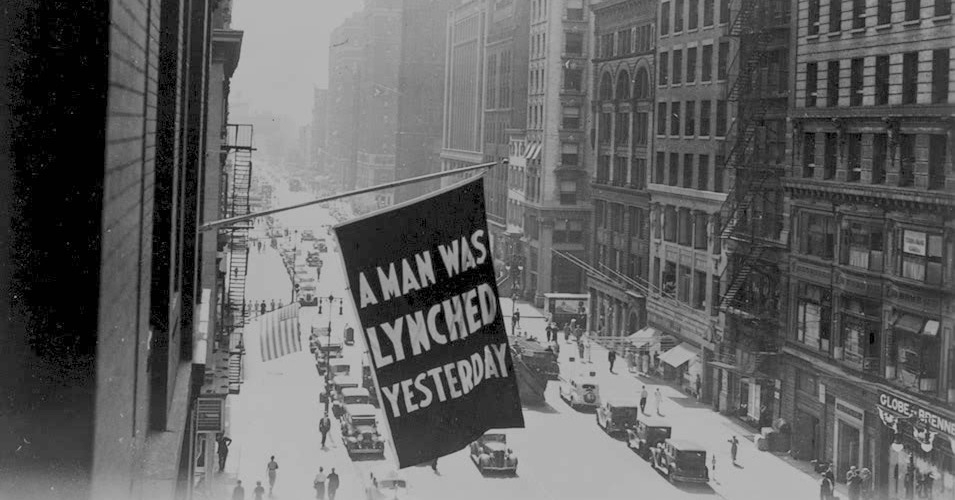New Report on Lynching Reveals America’s Sinister Legacy of ‘Racial Terrorism’
ANGLO AMERICA, 23 Feb 2015
Lauren McCauley – Moyers & Company

A flag announcing a lynching hangs from the window of the NAACP headquarters on 69 Fifth Ave., New York City. (Photo: Library of Congress)
Feb11, 2015 – Capital punishment and ongoing racial injustice in the United States are “direct descendents” of lynching, charges a new study, which found that the pre-World War II practice of “racial terrorism” has had a much more profound impact on race relations in America than previously acknowledged.
The most comprehensive work done on lynching to date, the investigation unearthed a total of 3,959 racially-motivated lynchings during the period between Reconstruction and World War II, which is at least 700 more killings than previously reported.
The report, Lynching in America: Confronting the Legacy of Racial Terror , published Tuesday by the legal nonprofit Equal Justice Institute (EJI), culminates the group’s multi-year investigation into lynching in 12 Southern states (Alabama, Arkansas, Florida, Georgia, Kentucky, Louisiana, Mississippi, North Carolina, South Carolina, Tennessee, Texas and Virginia) during that period.
These killings, EJI charges, are a form of terrorism. The “violent and public acts of torture” were widely tolerated, particularly by state and federal officials, and “created a fearful environment where racial subordination and segregation was maintained with limited resistance for decades.”
“The failings of this era very much reflect what young people are now saying about police shootings,” EJI Director Bryan Stevenson told the Guardian, connecting the widespread acceptance of lynchings historically with the current racial justice movement. “It is about embracing this idea that ‘black lives matter.’”
Stevenson continued: “I also think that the lynching era created a narrative of racial difference, a presumption of guilt, a presumption of dangerousness that got assigned to African-Americans in particular — and that’s the same presumption of guilt that burdens young kids living in urban areas who are sometimes menaced, threatened, or shot and killed by law enforcement officers.”
The report documents a number of cases where black individuals were tortured and murdered, often in front of spectators, for such “crimes” as bumping into a white person, wearing their military uniforms after World War I, or not using the appropriate title when addressing a white person.
The report further suggests that the decline of lynching was tied to the rise of capital punishment — “a more palatable form of violence.”
Capital punishment, the authors say, remains “rooted in racial terror” and is a “direct descendant of lynching.”
Between 1910 and 1950, African-Americans fell to just 22 percent of the South’s population but constituted 75 percent of those executed there during that time. And today, African-Americans compromise less than 13 percent of the nation’s population but nearly 42 percent of those currently on death row in America.
The report continues: “Modern death sentences are disproportionately meted out to African-Americans accused of crimes against white victims; efforts to combat racial bias and create federal protection against racial bias in the administration of the death penalty remain thwarted by familiar appeals to the rhetoric of states’ rights; and regional data demonstrates that the modern death penalty in America mirrors racial violence of the past.”
The authors hope that by confronting the reality of the country’s racial history, Americans can work toward addressing the contemporary problems that are lynching’s legacy.
“We cannot heal the deep wounds inflicted during the era of racial terrorism until we tell the truth about it,” Stevenson said.
____________________________
Lauren McCauley is a staff writer for Common Dreams.
This post first appeared at Common Dreams.
Go to Original – billmoyers.com
DISCLAIMER: The statements, views and opinions expressed in pieces republished here are solely those of the authors and do not necessarily represent those of TMS. In accordance with title 17 U.S.C. section 107, this material is distributed without profit to those who have expressed a prior interest in receiving the included information for research and educational purposes. TMS has no affiliation whatsoever with the originator of this article nor is TMS endorsed or sponsored by the originator. “GO TO ORIGINAL” links are provided as a convenience to our readers and allow for verification of authenticity. However, as originating pages are often updated by their originating host sites, the versions posted may not match the versions our readers view when clicking the “GO TO ORIGINAL” links. This site contains copyrighted material the use of which has not always been specifically authorized by the copyright owner. We are making such material available in our efforts to advance understanding of environmental, political, human rights, economic, democracy, scientific, and social justice issues, etc. We believe this constitutes a ‘fair use’ of any such copyrighted material as provided for in section 107 of the US Copyright Law. In accordance with Title 17 U.S.C. Section 107, the material on this site is distributed without profit to those who have expressed a prior interest in receiving the included information for research and educational purposes. For more information go to: http://www.law.cornell.edu/uscode/17/107.shtml. If you wish to use copyrighted material from this site for purposes of your own that go beyond ‘fair use’, you must obtain permission from the copyright owner.